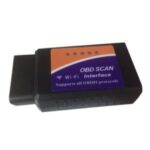Many owners of the classic 1994 Ford Ranger often wonder about diagnostic capabilities, specifically if their vehicle is equipped with OBD2. It’s a common misconception to search for “94 Ford Ranger Obd2” compatibility. However, the 1994 Ford Ranger, while advanced for its time, utilizes an OBD1 system and not the OBD2 system that became standard later. Forget needing a converter; your Ranger has its own built-in diagnostic method! This guide will walk you through how to easily read your 1994 Ford Ranger’s computer codes using just the Check Engine Light (CEL) and a simple jumper wire. Diagnosing your engine issues is more straightforward than you might think.
Locating the OBD1 Diagnostic Connector
First, you’ll need to find the OBD1 connector in your engine bay. This connector is your gateway to understanding what your Ranger’s computer is trying to tell you. It’s typically a rectangular, black connector.
Often, this OBD1 port will have a protective cap, sometimes labeled “EEC” (Electronic Engine Control), to keep out dirt and moisture. You might find it clipped to the engine fuse box or nearby within the engine compartment. Look for a single grey connector on the same wiring harness – this is also part of the diagnostic setup.
Reading OBD1 Trouble Codes Using the CEL
Once you’ve located the OBD1 connector, you can proceed to read the diagnostic trouble codes. This process involves using a jumper wire to initiate the self-test mode and observing the Check Engine Light flashes.
To start, you’ll need a small jumper wire or an unfolded paper clip. With the key off, locate the OBD1 connector and the separate single grey connector. Refer to the connector diagram to identify the correct slots.
You need to create a connection between the single grey connector, known as the “Self Test Input,” and the “Signal Return” slot on the larger OBD1 connector. By jumpering these two points, you’re telling the EEC to enter diagnostic test mode when you turn the ignition key to the ‘on’ position (without starting the engine).
Now, turn the key to the ‘on’ position and carefully watch the Check Engine Light on your dashboard. After a brief moment, the CEL will flash once as the computer boots up. Following this, it will begin to flash the diagnostic codes. For a 1994 Ford Ranger, these codes are three-digit numbers.
Let’s decipher an example: If you see one flash, a short pause, then one flash, another short pause, and finally six flashes, followed by a longer pause, this sequence represents code 116. It might seem confusing at first, but you’ll quickly get the hang of interpreting the flashes. The system will cycle through all stored codes and then repeat them, ensuring you catch every code. When you see a code sequence repeated, you know you’ve retrieved all the stored diagnostic codes. A code 111 indicates that no fault codes are currently stored in the computer’s memory, meaning no problems were detected during the self-test.
You can find a comprehensive list of 3-digit Ford OBD1 codes specifically for your 1994 Ranger at resources like The Ranger Station: https://www.therangerstation.com/tech_library/OBD1_EEC-IV_3digitcodes.shtml. This list will help you understand what each code signifies, pointing you towards the potential problem areas in your vehicle.
Clearing Diagnostic Codes
After you’ve noted down the codes and addressed the issues they indicate, it’s a good practice to clear the codes from the computer’s memory. With the key still in the ‘on’ position, simply remove the jumper wire from the OBD1 connector. This action will clear the stored codes. If you only turn off the key and remove the jumper, the codes will remain saved.
Clearing the codes is beneficial because it allows you to see if any new codes reappear after driving, indicating whether the problem has been truly resolved or if it persists. For instance, if you had a code related to “bad gas” causing rough engine running, once you’ve used up the bad fuel and refueled with good gas, the initial problem might be gone. However, the old code will still be stored, potentially leading you to chase a problem that no longer exists. Clearing the codes provides a clean slate for future diagnostics.
By following these steps, you can effectively diagnose your 1994 Ford Ranger using its OBD1 system and the Check Engine Light, without needing any specialized OBD2 converters. This simple yet effective method empowers you to understand your vehicle’s health and address potential issues promptly.

